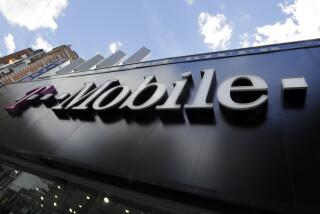Technology Pulls Plug on Rural Party Lines : West Virginia: Customers say farewell to their old telephone system with mixture of joy and nostalgia.
TALCOTT, W.Va. — The party line helped make great friends and great enemies and once even helped derail a presidential campaign.
Now, for rural telephone customers in West Virginia, the party’s over. Reflecting a national trend, the Chesapeake & Potomac Telephone Co. is hanging up its party lines after stringing them throughout the countryside for the first six decades of this century.
“The 16-party line service was basically used as an intercom. One person would call somebody else on the line and everybody would pick up,” said Kenneth Pitt, a spokesman for Bell Atlantic, C&P;’s parent company.
“The housewives would get on there and talk for two hours or maybe three hours. It was a different day and age. Those days are gone.”
There was a time, however, when telephone company workers like Sonny Stroud climbed mountains, crossed rivers and dug trenches to set up the party lines.
“Just being able to provide service, even on a party line, just thrilled us then,” said Stroud of Rainelle, who took a C&P; job in 1948. “We’d do anything to get the system to whoever wanted it.”
Phone service first came to southeast West Virginia in 1904, the majority of it through party lines. One-tenth of West Virginia’s telephone customers were on party lines on Nov. 1, 1985, when the Public Service Commission approved a C&P; request to eliminate that service.
“It’s considered a lesser quality of service--like driving the battered pickup truck versus driving a shiny new one with velour seats,” explained Pitt in an interview from his office in Arlington, Va. “It isn’t even seen as telephone service.”
Talcott residents made their last party line calls this summer. When a handful of Eastern Panhandle residents are switched over soon, all of C&P;’s 635,000 West Virginia customers will be on private lines.
One customer who is happy about that is Jim Monroe Jr. of Greenbrier Nurseries, which was on a party line for 31 years--”a terrible inconvenience.”
“Most of the time we had it, we had only one other person on it. There was this family up at Barger Springs, they were a Greek family that barely spoke English, so they barely made phone calls.
“But then there once was another woman who spread gossip around and was on the phone all the time.”
The business now plans to install a toll-free 800 number, something not possible on a party line.
Around the nation, 2.8 million people remained on party lines at the end of 1987, the latest year for which figures were available, according to the United States Telephone Assn. In 1985, there were 4.6 million party lines.
The Rural Electrification Administration in Washington, D.C., which lends money to rural telephone companies that serve 5 million people, still will handle requests from four-party line systems.
But, said Fred Albrecht, an REA telecommunications specialist, “I don’t know of one made in the last 10 years.”
“We discourage them. In today’s age, you can build a one-party plant as cheaply as a four-party plant.”
Although party lines could promote neighborliness, they sometimes did the opposite.
Eight families were on a line operated by a Missouri company Albrecht once worked for. One of the families had eight children; another, nine.
“One day, the other six people on the line all showed up at my office to complain that they couldn’t get to the phone. We put the other six on one line and put the families with the 17 kids on the other.”
When the two big families continued to complain, he said, “We told them they would have to work it out.”
It wasn’t unusual to have even more people on the line, said Jim Davis, an external affairs manager for C&P;, recalling one copper line that had five 10-party lines. “It was so hot they had to use gloves to handle it.”
Nowadays, thousands of calls can be routed simultaneously on fiber-optic cables. A standard cable with 12 pairs of lines can handle hundreds of customers as computerized equipment switches from line to line thousands of times per second and sends voice and data impulses--clean and crisp.
Even though private-line service will add a little more than $4 to the roughly $17 monthly phone bill for the average family formerly on a party line, customers like Sara Sowers are not complaining.
“It’s better this way. You can go to the phone and just pick it up,” she said. “Before, you had to pick it up to see if anyone was on it. Then you would pick it up a little later and they’d still be on there. You just had to keep picking it up.”
And sometimes you had to put it down too--as the late Hubert H. Humphrey learned during West Virginia’s Democratic presidential primary race in 1960.
Two days before the vote, Humphrey held a slight lead over John F. Kennedy in the polls and purchased half an hour of television time for a statewide call-in show.
Theodore H. White, in “The Making of the President, 1960,” wrote that Humphrey already was flustered by callers straying from the topics when a voice interrupted a party line calling, “Clear the wires! This is an emergency!”
“Humphrey attempted to explain they were on the air, they were answering questions to a TV audience,” White wrote. The voice again ordered Humphrey and his caller to surrender the line, and the candidate, “his face blank and bedazzled, hung up, shaken, to press the button for another call.”
Kennedy won the primary and the presidency.
More to Read
Sign up for Essential California
The most important California stories and recommendations in your inbox every morning.
You may occasionally receive promotional content from the Los Angeles Times.










